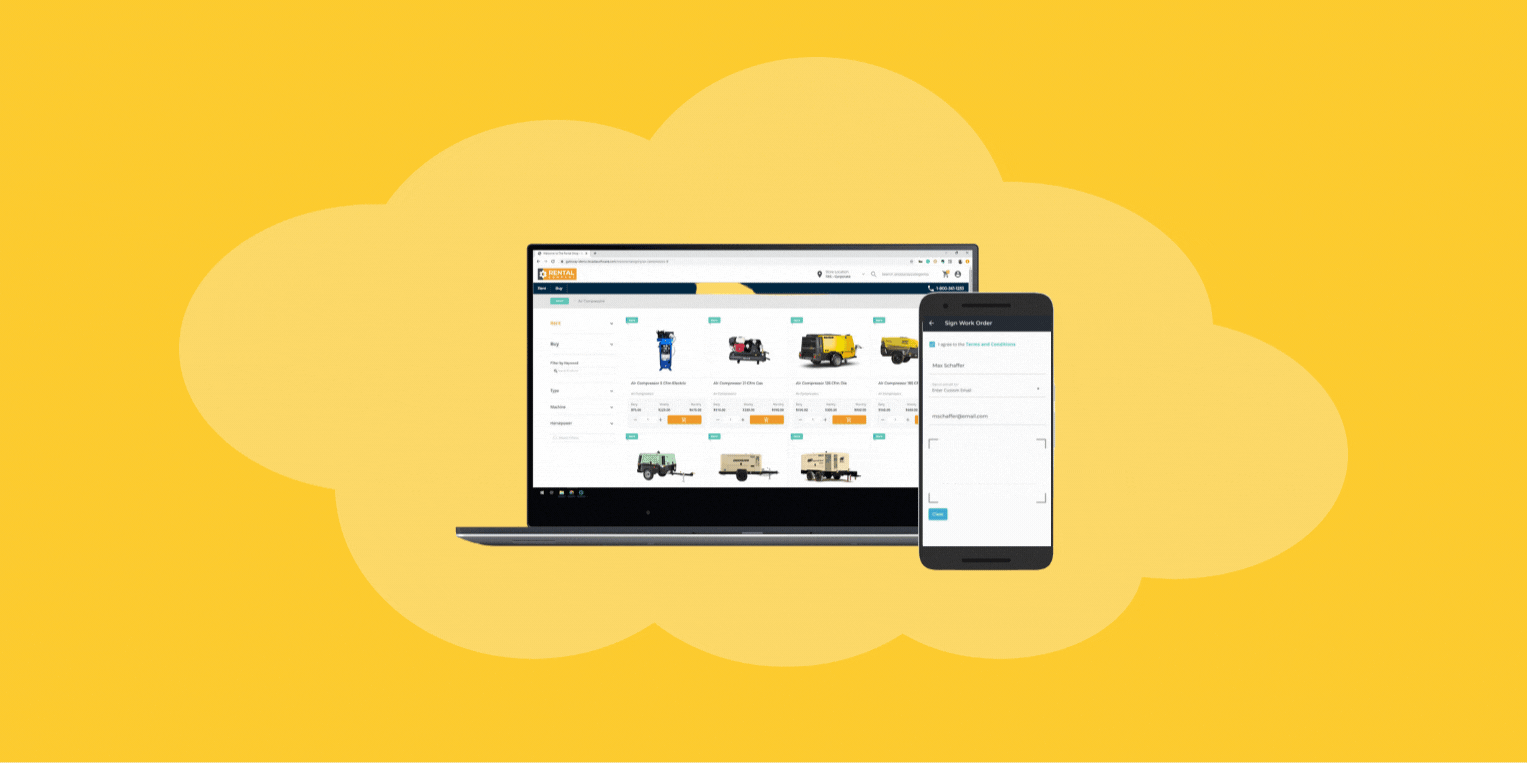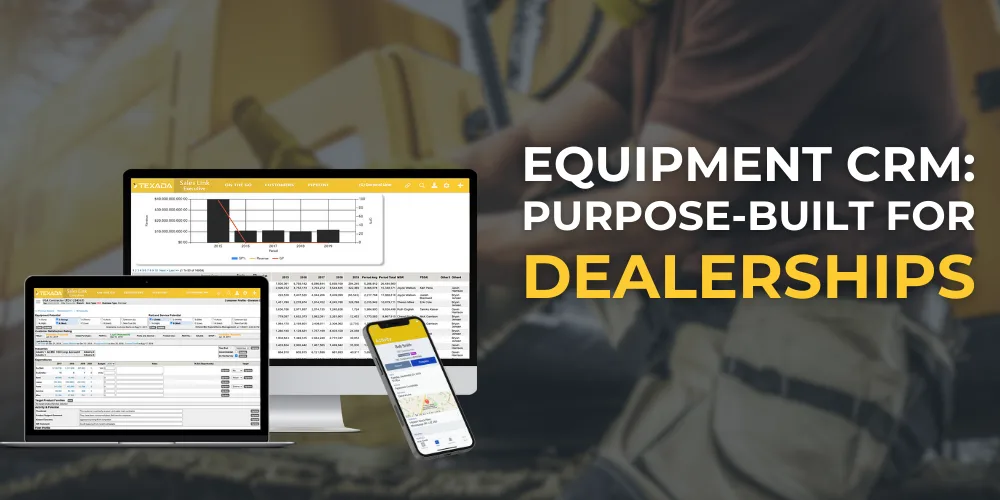The equipment rental industry is embracing a tech revolution that’s reshaping how businesses operate and evolving how customers seamlessly rent equipment. As Steve Jobs once said, ‘Innovation distinguishes between a leader and a follower.’ This rings truer than ever in an era where digital trends are not just tools but game-changers. Let’s dive into the latest waves of digital transformation sweeping through the equipment rental landscape, unlocking efficiency and delighting customers along the way.
Digital Work Orders and Inspection Reports Are the New Norm
Exchanging paperwork orders and sheets for Excel files, rental companies have accelerated their migration towards digital technology. However, as technology evolves, it’s becoming clear that the old way of leveraging digital technology won’t cut it. As such, many companies in the rental industry are investing in technology that empowers their team with mobile functionality on their smartphones and tablets. The ability to obtain repair status accurately and in real-time allows the service team to communicate information back to customers instantly. Real-time data such as the location of a dispatched service technician, what parts are available, and when a work order has been completed allows customers to assess any potential delays on the job site quickly. When there is a damage dispute, photo records showing images of the equipment before and after the rental and any repair history provide rental companies with a fair assessment of the situation. It gives customers greater peace of mind.
Online Portals Are Steadily Gaining Traction
Customers prefer online methods when booking, extending, or ending a rental. An online portal empowers customers to reserve their equipment online, check invoices, pay outstanding rentals, and off-rent equipment for pickup. Although accessing accounts online is a norm in other industries, such as hotels and auto rentals, the equipment rental industry is catching up. In the coming years, an online portal will likely be a required feature for any rental company wanting to provide a great customer experience.
Pen and Paper Need to Stay in the Past.
Still operating using paper contracts hand-signed on a dotted line? There is some psychological comfort to confirming a commitment on paper. However, we have found that instantly sending a signed contract with an e-signature back to a customer is much more convenient. Being notified when all parties have signed and having a searchable record in an online repository makes it much easier to complete a rental transaction. When customers sign on a mobile device or computer, there is no need to access a printer or scanner, and rental transactions become almost instant. Compare that to the old pen and paper system, where a signed contract can take hours, if not days, to be returned. E-signature is here to stay and has become a powerful tool to ensure transparency and efficiency in facilitating agreements.
On-The-Move Management with Mobile Apps
The equipment rental industry rapidly embraces mobile applications, enabling efficient on-the-move management. As businesses in this sector seek greater convenience and responsiveness, mobile apps are essential for staying competitive in the digital age. Mobile apps have revolutionized the way equipment rental companies operate. By allowing employees to manage reservations, track equipment, and process payments from anywhere, these applications empower businesses to handle operations beyond the confines of a traditional office setting.
Features That Enhance Customer Service and Internal Management
- Real-time Inventory Management: Mobile apps provide employees instant access to inventory levels, ensuring customer queries can be answered promptly and accurately.
- On-Demand Booking and Scheduling: Customers can make and adjust reservations directly from their mobile devices, improving convenience and satisfaction.
- Mobile Payment Integration: Secure payment options within the app help streamline the rental process, leading to quicker service and reduced wait times.
- Personalized User Experiences: By leveraging user data, mobile apps can offer personalized recommendations and services tailored to individual customer needs.
Optimizing with the Internet of Things (IoT)
The equipment rental industry is undergoing significant transformation, thanks largely to the advent of the Internet of Things (IoT). By integrating IoT technology, businesses within this sector can track and maintain their inventory in real-time and substantially improve operational uptime and customer satisfaction. IoT technology enables rental companies to monitor their equipment remotely. Sensors attached to the equipment can send real-time data regarding location, usage, and maintenance needs. It facilitates on-the-fly tracking and servicing, helping to prevent equipment downtime and ensuring that all assets are in excellent condition for the next rental.
Improving Uptime and Customer Satisfaction
By leveraging IoT, rental businesses can minimize unexpected breakdowns through predictive maintenance. Automated alerts about the health of the machinery can help in scheduling maintenance before a failure occurs, which not only extends the life of the equipment but also maximizes availability. This proactive approach directly contributes to customer satisfaction by providing reliable and ready-to-use equipment.
Real-world Applications in Construction and Other Sectors
- GPS-enabled equipment: Allows for tracking the location of machinery on large construction sites.
- Usage monitoring: Ensures equipment is used correctly and within operational guidelines, reducing wear and tear.
- Remote diagnostics: Immediate identification of issues enables quicker responses, minimizing delays and potentially reducing the need for onsite repair visits.
Leveraging Big Data Analytics
Understanding customer behavior to improve service delivery has become a cornerstone in the equipment rental industry. Companies can gain actionable insights into customer preferences and rental patterns using sophisticated data analytics tools. This intelligence enables businesses to tailor their offerings, ensuring customers receive the most efficient, on-point service and enhancing satisfaction and loyalty.
Fleet optimization to meet demand without excess inventory is another major benefit of leveraging big data. Analytics can predict peak rental periods, allowing companies to adjust their inventory levels accordingly. This balance helps to minimize costs associated with maintaining surplus equipment while ensuring availability when customer demand spikes.
To realize these benefits, businesses must adopt effective data analysis practices. It involves integrating the right technological tools and fostering a data-driven culture within the organization. Staff should be trained to understand and utilize data in decision-making processes, creating a company-wide synergy focused on constant improvement guided by robust data analytics.
- An in-depth analysis of rental usage patterns helps tailor marketing and operational strategies.
- Cost savings by reducing downtime and avoiding overstock with predictive analytics.
- Enhanced customer experiences through personalized services based on customer data.
Virtual Reality: A New Paradigm for Inspection and Training
The equipment rental industry is witnessing the emergence of Virtual Reality (VR) as a transformative technology for inspection and staff training. This digital trend sets new standards for businesses conducting routine procedures and onboarding new employees. Virtual Reality allows for remote equipment inspection, enabling experts to evaluate machinery without being physically present. It not only saves time but also broadens access to specialized knowledge. Furthermore, VR-driven staff training programs immerse trainees in lifelike scenarios, thereby effectively increasing the retention of skills and knowledge without the risks associated with on-site training.
Enhancing Safety and Reducing Downtimes
By incorporating VR into safety protocols, rental businesses drastically reduce the risk of accidents. Trainees can learn how to operate heavy machinery in a controlled virtual environment, directly contributing to fewer on-site incidents. Additionally, VR allows for interactive troubleshooting and maintenance training, reducing equipment downtimes and operational interruptions.
Adapting VR into Small to Mid-Sized Business Environments
While VR technology may have once seemed exclusive to large enterprises with substantial resources, it is now becoming accessible to small and mid-sized businesses in the equipment rental industry. As VR hardware and software become more cost-effective, these enterprises are discovering innovative uses, significantly enhancing their competitive edge in an increasingly digital market landscape.
- Remote Inspections: Minimize travel costs and access expertise from around the globe.
- Training Efficiency: Accelerate the learning curve with hands-on VR experiences.
- Safety Improvements: Conduct hazard-free simulations to prevent workplace injuries.
- Cost Reduction: Lower traditional training expenses and mitigate the risk of equipment damage.
Pro Tip: Implement VR Training Programs to enhance safety and efficiency by providing lifelike, hands-on experiences that reduce on-site incidents and downtime while being cost-effective for small to mid-sized businesses.
Artificial Intelligence in Predictive Maintenance
Artificial Intelligence (AI) is swiftly becoming a game-changer in the equipment rental industry, particularly in its application to predictive maintenance. This advanced technology offers the ability to preemptively flag potential equipment malfunctions before they happen, ensuring maximum uptime and customer satisfaction. By leveraging AI analytics, rental companies can optimize inventory levels, reduce downtime, and significantly cut maintenance costs.
AI’s Role in Preventing Equipment Failure and Optimizing Inventory
Implementing AI-driven algorithms enables businesses to monitor equipment health in real-time and predict when maintenance or replacement is necessary. This preventive maintenance approach to servicing reduces the risk of sudden equipment failures that can disrupt operations. Moreover, companies can better manage their inventories, balancing demand and maintenance needs and avoiding overstocking or underutilization.
Guidelines for Integrating AI in Equipment Rental Businesses
- Assess Data Readiness: Ensure you have the right infrastructure to collect and process data from your equipment.
- Choose the Right AI Partner: Work with experienced AI solution providers who understand the nuances of the equipment rental industry.
- Invest in Training: Provide proper training for your team to harness AI’s power in predictive maintenance fully.
- Start Small: Start with a pilot program to validate AI’s benefits before expanding its use across your fleet.
- Integrate with Existing Systems: Implement AI to complement and enhance your maintenance processes and systems.
Embracing Contactless Payments in the Equipment Rental Industry
The equipment rental industry has recognized the escalating importance of digital financial services in streamlining rental transactions. In today’s fast-paced world, customers seek quick and efficient service delivery, and the incorporation of contactless payments into the rental process reflects this trend.
As digitization continues to sweep across various business sectors, the equipment rental industry is also transitioning to these advanced systems. Contactless payments offer customers a hassle-free way to manage their transactions, reduce wait times, and enjoy a modern rental experience that aligns with their everyday use of technology.
Ensuring Secure and Convenient Payment Processes
The primary concern with digital transactions is security. The industry is adopting robust encryption and authentication protocols to ensure that user data and payment information remain secure, addressing these concerns head-on. By prioritizing customer trust and convenience, equipment rental businesses can provide a seamless checkout experience that enhances customer satisfaction and loyalty.
Adapting to Consumer Demand for Seamless Rental Experiences
Contactless payments are not just a trend but have become a consumer expectation. To stay competitive, the equipment rental industry is adapting quickly. Offering features like one-click payments, mobile wallet compatibility, and contactless card machines are key adaptations that can define the customer’s rental experience as modern, efficient, and delightful.
By embracing these digital trends, Special Equipment Rentals aims to meet and exceed industry standards and pave the way for a future where digital convenience is at the forefront of customer service.
Pro Tip: Prioritize Security and Convenience by adopting robust encryption and authentication protocols for contactless payments. This will ensure a seamless and secure checkout experience that meets modern customer expectations and enhances satisfaction and loyalty.
CRM Integration for Enhanced Customer Management
The equipment rental industry is experiencing a transformation influenced by digital innovations. One of the pivotal changes is the adoption of Customer Relationship Management (CRM) systems. Integrating advanced CRM tools streamlines operations and strengthens the core of any business–customer relationships.
Strengthening Relationships Through Digital CRM Tools
Using digital CRM platforms in the equipment rental industry fosters long-term client relationships. Businesses can achieve a more personalized and responsive service experience by centralizing customer information and interactions.
Personalizing Communication and Tracking Customer Interactions
CRM systems enable equipment rental companies to tailor their communication strategies based on customer preferences and history. This personalized approach, combined with the ability to track all customer interactions, ensures a high level of service consistency and customer satisfaction.
E-Commerce Strategies for Equipment Rentals
The evolution of digital technology has significantly altered the landscape of the equipment rental industry. Key players are embracing e-commerce strategies to stay competitive and meet the growing demands of a digital-first customer base. Implementing these strategies effectively can enhance business operations and increase customer satisfaction.
One of the foremost strategies is listing equipment on digital marketplaces. These platforms offer a vast audience seeking rental solutions, thereby increasing the visibility of rental inventories. By leveraging these marketplaces, businesses can reach potential customers they otherwise might not have engaged with, ultimately leading to greater brand exposure and revenue growth.
Transitioning from Traditional to Online Sales
Equipment rental companies must move from a predominantly brick-and-mortar business model to an online sales platform. This transition modernizes the rental process and offers customers the convenience of browsing, booking, and paying for rentals anytime and anywhere. The digitalization of sales allows for more streamlined operations and better resource management within the company.
Impact of E-Commerce on the Rental Industry
The impact of introducing e-commerce into the rental industry has been transformational. With the aid of online platforms and e-commerce strategies, rental companies are experiencing improved inventory turnover, more accurate tracking of equipment, and enhanced analytics for business decisions. Moreover, customers benefit from user-friendly interfaces and transparent pricing models, contributing to a more satisfactory rental experience.
- Increased efficiency in rental transactions
- Broader reach to potential customers through online channels
- Improved customer engagement and support
- Real-time inventory management and dynamic pricing capabilities.
Pro Tip: Leverage Digital Marketplaces to expand your customer base and increase visibility. Listing equipment on popular online platforms boosts brand exposure and drives revenue growth by reaching audiences you might otherwise miss.
Telematics for Real-time Management
| Aspect | Description |
| Telematics Technology |
|
| Remote Equipment Monitoring |
|
| Impact on Fleet Efficiency and Security |
|
| Implementation Steps |
|
| Benefits of Telematics |
|
Embracing the Future of Equipment Rentals
The equipment rental industry stands on the brink of a digital revolution. Throughout this article, we’ve highlighted the significant digital trends shaping the sector, from the ubiquitous rise of online booking and reservation systems to the cutting-edge adoption of virtual reality for training and inspection purposes. It’s evident that technology enhances operational efficiency and redefines how businesses connect with customers and manage assets.
Adopting new technologies is no longer a luxury but a necessity for those looking to stay competitive in an ever-evolving marketplace. Industry leaders are integrating mobile app functionalities, leveraging IoT for optimized equipment management, and utilizing big data for actionable insights. Furthermore, the evolution of cloud computing continues to provide robust, scalable storage solutions crucial for modern businesses’ vast data needs.
Innovation extends to customer interaction with the introduction of augmented reality to enhance customer engagement, while CRM integration ensures superior customer relationship management. By embracing these digital advancements, your business can streamline operations and substantially increase customer satisfaction and retention.
Key Takeaways
- The equipment rental industry is moving from traditional paper-based processes to digital work orders and online portals. This shift allows for real-time communication and efficient management, enhancing transparency and customer satisfaction by enabling instant updates on repair status and equipment availability.
- Mobile app development and Internet of Things (IoT) integration are transforming rental operations. Mobile apps facilitate on-the-go management, real-time inventory tracking, and mobile payments, while IoT enables remote monitoring and predictive maintenance, reducing equipment downtime and improving operational efficiency.
- Artificial Intelligence (AI) and Big Data analytics are becoming essential tools in the rental industry. AI-driven predictive maintenance helps prevent equipment failures, while Big Data provides actionable insights into customer behavior and rental patterns, optimizing inventory levels and enhancing service delivery.
- The equipment rental industry is adopting e-commerce strategies and contactless payments to meet digital-first customer expectations. This transition enhances the rental process by offering convenient online booking, payment options, and seamless transaction experiences, contributing to improved customer engagement and satisfaction.
Forge Ahead with Digital Transformation
As we look to the future, the importance of digital transformation in the equipment rental industry cannot be overstated. It’s an opportunity to keep pace with competitors and outstrip them by offering advanced, efficient, and customer-centric services. Therefore, we encourage equipment rental businesses to adopt and adapt to these trends, ensuring resilience and success in a digital-first world.
Ready to take the next step? Speak with one of our experts today to learn how Texada’s purpose-built software solutions can help your business step into the future.





